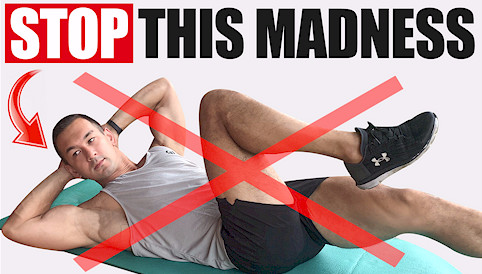WHY AB WORKOUTS ARE A WASTE OF TIME (DO THIS INSTEAD!)
If you want impressive abs and a strong core, stop doing the typical ab routines you find all over YouTube and Instagram.
In this article, you’ll discover why the “14 minutes ab shredding workouts” you’ve probably seen online are not effective. And, you will learn what to do instead to get eye-catching abs.
To get started, let’s cover the first flaw of most ab workouts.
You Cannot Spot Reduce Belly Fat
Many of the ab training videos online claim that you can get lean with their workouts. In reality, that is not true. The research is clear on the fact that you cannot spot reduce belly fat through exercise.
For example, a 2011 study published in The Journal of Strength and Conditioning Research had subjects do four hours of ab training a week for six weeks.
The result? Despite those efforts, the ab exercises produced no belly fat loss or fat loss in general. Here is what the researchers concluded:
“There was no significant effect of abdominal exercises on body weight, body fat percentage . . . abdominal circumference, abdominal skinfold and suprailiac skinfold measurements.”
Put differently, endless amounts of sit-ups and crunches will not give you a slim and shredded midsection. So, ab workouts are not effective from a fat loss perspective.
That is important to note because having defined abs is primarily about being lean. No matter how much you train your abs, they will not show up if they are covered by a layer of fat.
The solution is staying in a calorie deficit over time and tracking its progress. Doing so burns fat from your entire body as a whole, but you cannot influence where that fat comes from.
There will be stubborn spots that are harder to slim down—it takes longer to lose fat in those areas. For men, this is often the case for the midsection.
So, when you do ab workouts, you target the ab muscles underneath the layer of fat. But at the end of the day, no amount of ab training on its own will get you a six-pack. It comes down to being lean enough.
The Real Purpose Of Ab Exercises

Contrary to stimulating fat loss, muscle growth is the primary purpose of ab exercises.
Your abdominals are skeletal muscle tissue like any other muscle. They respond to resistance training in the same way a muscle like your biceps or quads would.
If your goal was to maximize quad growth, would you do a random bodyweight workout where you rotate through eight exercises like bodyweight squats and lunges with no rest between sets?
And would you prance around your living room for fifteen minutes and then call it a day, expecting to build big legs from doing that?
Or would you select solid exercises like the barbell squat and leg press, use a “hypertrophy rep range,” get close to muscular failure, take full rest periods between sets, and focus on applying progressive overload?
Interestingly, most people know that you need to use a relatively decent amount of weight and focus on applying progressive overload if you want to build muscle.
But when it comes to the abs, that logic gets thrown out of the window. The same people opt for 15-minute ab workouts consisting of low-intensity ab exercises like crunches and lying leg raises.
Sure, that might produce some muscle building results, especially if you are a beginner trainee. But it is by far not the most effective approach. There is no reason to treat your abs any differently than any other muscle groups.
The goal of ab training is to provide the muscle with an optimal hypertrophy stimulus. To do that, you should train this muscle group with the same principles that you would apply to your biceps or quads.
Please note: I am not saying that ab training in general is a waste of time. It is these dedicated pump-style, 12-minute ab workouts that make no sense. (Or at least they are not the most effective way to train.)
Are Compound Exercises Enough for Building Abs or Should You Isolate Them?
Your abs do receive indirect stimulation during many compound exercises that you do for other muscles. And, most people do not need high volumes of abdominal training for the desired result.
However, direct ab work, even if it is just once a week, is beneficial as part of a well-rounded hypertrophy and strength program.
A study that assessed muscle activity levels during various exercises including the back squat confirmed this.
The subjects performed the back squat with 90% of their 3RM (a decent amount of weight). But ab muscle activation levels did not even reach 20% of maximum voluntary contraction!
To provide a comparison, the straight-leg sit-up led to more than double the amount of rectus abdominis and external oblique activation.
What’s more, compound exercises like the squat, deadlift, overhead press, and chin-up train your abs statically. That is not ideal for muscle growth.
Instead, dynamic movements are better for maximizing hypertrophy because both the concentric and eccentric phase of an exercise offer benefits that you do not reap with static contractions.
Here’s What I Recommend You Do

Add direct ab exercises into your workout routine. Just pick a couple of ab movements that feel good for you and engage your abs effectively.
Push those movements within a few reps of failure, and take enough rest between sets to recover. And, focus on applying progressive overload.
You can apply that progressive overload by increasing the resistance that you use over time. Or, you could focus on doing more reps.
Regarding exercise selection, there are many movements that you can choose from. But a basic crunch-type movement should be the primary go-to exercise.
The reason is that the main function of the rectus abdominis is spinal flexion. With a crunch-type exercise, you train that movement pattern optimally.
The kneeling rope crunch is my favorite. But you could also do a machine crunch, banded crunch, or a weighted crunch on a decline bench or the floor.
A leg raise movement is an excellent addition to a crunch-based exercise. You could do a lying leg raise or hanging leg raise, and the reverse crunch is also great.
To finish off, add an isometric core exercise like a plank variation or the ab wheel rollout. Such exercises are excellent for core stability and general spinal health.
You do not need anything fancier. Two to three movements where you can engage your abs, get close to failure, and apply progressive overload will get the job done.
For rep ranges, any can induce muscle growth if you get close enough to muscular failure. But do not fall into the idea that you must do ab exercises for ultra-high reps in order to see results.
Very low rep sets may also not be ideal because ab movements usually have a shorter range of motion, and you want to make sure your abs are doing the bulk of the work and not your lower back or hip flexors.
The mind-muscle connection is a bit more important for ab training, but if your form is solid, there is no reason you cannot go as low as eight reps per set.
You could go as high as twenty or thirty. But around eight to fifteen reps is a pretty good general sweet spot.
Again, take enough rest between sets. If you are going hard, you probably need at least a full minute. That will keep your performance high and help you apply progressive overload.
The Bottom Line On Ab Workouts
Stop believing that you can spot reduce belly fat by doing ab exercises, or that you should train your abs differently than other muscle groups.
To get lean and well-defined abs, you will have to achieve a low enough body fat percentage, which you do by being in a calorie deficit. And you will have to develop your core muscles to a sufficient extent.
You can do the latter by training your abs like you would train any other muscle. In other words, focus on a “hypertrophy rep range,” take enough rest between sets, and apply progressive overload.
Don’t fall for other overhyped fat loss myths either.
If you found this article helpful, make sure to sign up for your FREE custom fitness plan below...





